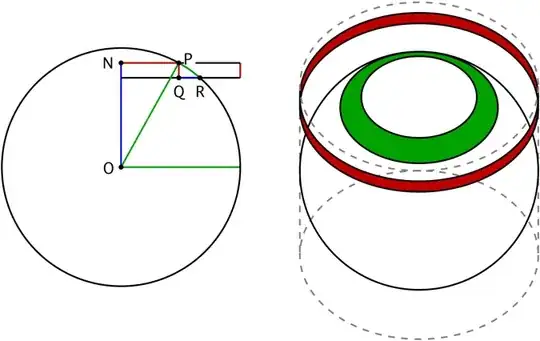My question revolves around the following property:
Let ${\bf u} \in \mathbb{R}^3$ be a random vector with uniform distribution on the three-dimensional unit sphere. Then the projection on any given unit vector $\bf v \in \mathbb{R}^3$ $$X = {\bf u}^\mathrm{T} {\bf v}$$ has uniform distribution $$X \sim \mathcal{U}(-1,+1).$$
This can be proven easily by first arguing that $X$ has the same distribution as any canonical projection of $\bf u$ because of symmetry and then employing some geometry [which I did here under (12)]: for $x\in[-1,+1]$, write the CDF of $F_X(x)$ as the ratio of the surface areas between a cap of height $1+x$ of the unit sphere and the entire unit sphere. Quite surprisingly, the surface area of the cap is linear in its height $x$ and you get $$F_X(x) = \frac{2\pi(1+x)}{4\pi} = \frac{1+x}{2}$$ which is a uniform distribution on $[-1,+1]$ and finishes the proof.
My Problem: This seems like a very appealing property of three-dimensional space. It's so simple that certainly thousands of mathematicians have stumbled upon it. Yet I cannot find other sources or material on it. I use the property heavily in my work and I want as much info about it as possible, plus a strong mathematical source. I'm confident about my proof and of course I verified everything numerically, but I don't like being self-referential on such a basic thing.
My Question: Could you please provide me with the following?
- One or more good sources on the property.
- As much fruitful information and intuition about it as possible.
Thank you very much!
Appendix: Here's some more info that could ignite the discussion. For the same thing in $\mathbb{R}^1$ you get a discrete uniform distribution on $x \in \{-1,+1\}$. In $\mathbb{R}^2$ you get the PDF $f_X(x) = 1 /(\,\pi\sqrt{1-x^2}\,)$ with poles at $x = -1$ and $x = +1$. This shows: the lower the dimension, the more likely it is that $\bf u$ hits a direction similar to $\bf v$. For $\mathbb{R}^N$, the probabily mass of $f_X(x)$ becomes more and more concentrated near $0$ with increasing $N$ because high-dimensional random vectors tend to be orthogonal.
